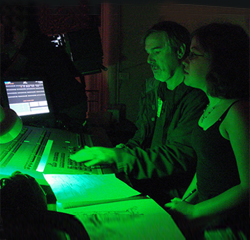An excerpt from Concert Lighting Techniques, Art and Business, 3rd Edition, published by Focal Press.
While doing the layout and color chart, you must be thinking ahead to how the cues will work with your plan. Does the layout give you the degree of flexibility you want? Does the color chart work as a palette in harmony with the music?
A separate design skill now enters the picture. The designer must take the raw data from the light plot and make the design come to life in the same way a musician does with notes in the score.
From the first time you hear the artist’s music, you should be mentally planning the choreography of your lighting, breaking down the music into cue points. Songs are like movies and novels; they have formulas. If you listen to a song all the way through first before writing anything, you will hear the formula or flow of the sound.
The usual formula can be identified as intro, verse 1, verse 2, bridge, and chorus, which repeat, followed by verse, bridge, chorus, and a buildup to a guitar solo or instrumental melody, bridge, chorus, and end.
Each and every song has some variation on this formula — not exactly as described here because some portions will be reversed or added in a different order — but most commercial pop songs have what is referred to as a hook. This is generally the title of the song and is the part of the song that fans remember and sing.
Often, the hook has an anthem style and is considered to be the chorus. The bigger the anthem, the bigger, more intense, and more animated the lighting and effects should be.
Cues, Song Punctuation
The concert lighting designer’s job is to complement the song and enhance the experience, not overshadow ot. I have seen concert lighting where every song looked exactly the same with lights flashing to every drum beat and guitar riff. It was so nauseating that my favorite part was the blackout at the end. The artists spend considerable time writing their songs, rehearsing them, producing and recording them.
This labor of love has structure and deep meaning to the artist and loyal fans. It is not possible to take short cuts in writing and producing music and have it be successful to the degree that people will pay to see their favorite artists in concert. Concert lighting is a visual translation of that music, and the lighting requires an equally professional approach to the process of creating cues, just as much as much it did to create the music.
Sometimes a song is easy to translate into lighting, such as a ballad or an anthem, and a sometimes it isn’t, such as a complicated rock song that is thematic with extreme highs and lows, even tempo changes.
Regardless, each song requires attention to detail so it will not be anticlimactic and you will have something left in your bag of tricks for the ending. The only way to accomplish that is to be patient and take the necessary time to structure the song and schedule effects for the entire song set.
I approach new music in the same way I was taught to read a script. You read it three times: first for the fun of reading it, second to find the written stage directions that affect lighting cues, and a third time to fi nd potential cues hidden in the dialog. I approach a song the same way.
The first time, I listen to it for the sheer enjoyment, and the second time I try to pick out the cue points, accents, verse and choruses, and tempo changes. The last time I listen for
the “color” of the song: happy, yellow and orange; moody or melancholy, blue and lavender; fiery and hot, red; soothing, green and blue – green. Listen to music with your eyes closed, and try to visualize the colors that might be associated with it.
Picking The Console To Match The Cues
Analyzing a song helps you determine the type of lighting console you will need. Manual consoles are almost a thing of the past, but many hybrid consoles allow manual operation with recorded cues that can be accessed when needed. I was one of the first to take a computer console on tour, the early Light Palette by Strand Lighting. My reasoning at the time was that the artist, John Denver, had a very large song list to draw from and he was performing without an opening act, thus making for almost 2 hours of music.
The computer allowed me to design each look using smooth, subtle cues that were absolutely repeatable and to write them directly into the memory. I devised a way to retrieve each song no matter what the order.















